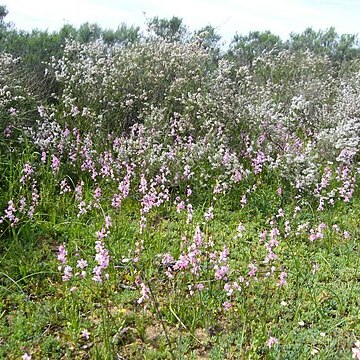Plants mostly 250-500 mm high. Corm 10-15 mm diam., with cormlets at base, especially numerous in subsp. toximontana; tunics of medium-textured to coarse fibres. Stem often with 1 or 2, rarely up to 6, branches, occasionally simple. Leaves 3 to 7, mostly in basal fan, 1/3-1/2 as long as stem, lanceolate or falcate, (3-)6-20 mm wide, main and sometimes additional veins raised but not thickened, margins markedly thickened in subsp. toximontana, occasionally undulate(-crisped) in subsp. scillaris. Spike erect, fairly lax, flexuose to ± straight, secund in 2 ranks, mostly 10-to 20-flowered; bracts membranous, translucent, sometimes turning purple distally, 3-5 mm long, outer prominently 3-veined and 3-toothed, inner 2-veined and 2-toothed. Flowers ± nodding with tepals held vertically with lowermost slightly reflexed, zygomorphic with stamens unilateral, bright to pale pink, occasionally white, tepal bases yellow or white edged in darker pink, lightly rose-scented or unscented; perianth tube filiform, 2.5-4.0 mm long, tightly clasping style; tepals ovate-elliptic, (8-)10-15 x 5-9 mm, inner 3 slightly larger than outer, lowermost tepal held apart. Filaments unilateral, inserted at mouth of tube, 1.6-3.5 mm long, arching upward near tips, white to pale yellow; anthers oblong-linear, 2.3-4.0 mm long, parallel, horizontal or slightly pendent, thecae recurved, acute at base, dehiscing incompletely from base, yellow. Style dividing ± opposite base of filaments, branches ± 1.5 mm long, pale yellow, falcate, tubular.
Cormous geophyte, 250-500 mm tall, often with 1-3 short branchlets. Leaves sword-shaped, the margins sometimes undulate. Flowers 18-51 cm a fairly lax spike, pale or deep pink, perianth tube filiform, 3-4 mm long, tepals more-or-less vertical, spreading, 8-16 mm long, stamens fully exserted, unilateral, anthers nodding.
Cormous geophyte, 25-50 cm. Leaves (3)4-7 in 2-ranked fan, sword-shaped to falcate, margins sometimes undulate. Flowers pale or deep pink or white, tube filiform, anthers oblong, unilateral and drooping.

